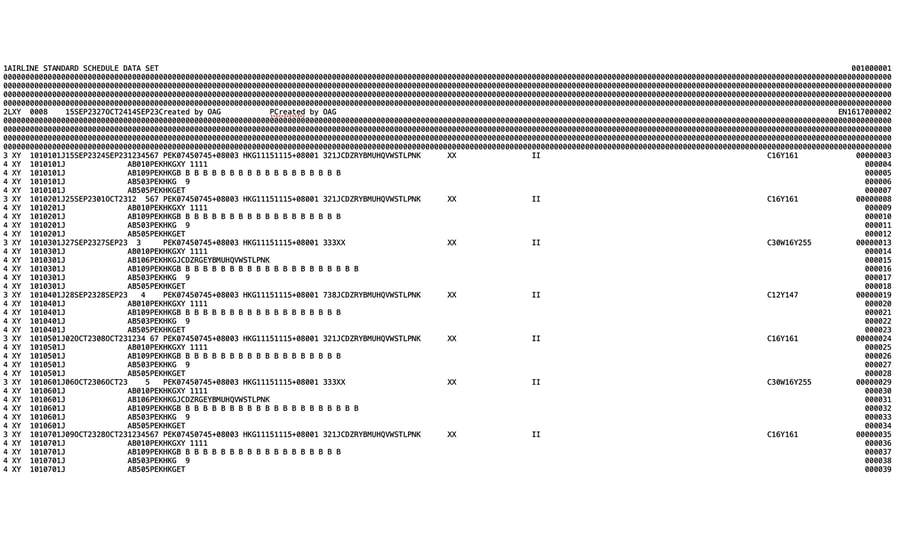SSIMs are the grease that oils the wheels of the airline industry, created in 1976 by the International Air Transport Association (IATA) with a goal to standardize how airline schedules are shared and distributed. What we commonly refer to as SSIM is a particular chapter (chapter 7) in the Standard Schedules Information Manual (SSIM), which also covers SSMs\ASMs, MCTs and Slots.
Key Points About SSIM Data:
- SSIM (Standard Schedules Information Manual) standardises airline schedule data exchange, enabling consistent, accurate communication across the industry.
- Created by IATA, the SSIM file uses a fixed format and includes key information such as aircraft type, cabin class, codeshares, and operational data.
- The standard delivers benefits including reduced ambiguity, easy integration, data consistency, streamlined slot management, and enhanced industry collaboration.
- SSIM supports advanced distribution control features, like Release Sell Dates, allowing airlines to manage when schedule data is made public.
- The SSIM format continues to evolve to address industry needs, shaping the way schedules are exchanged as new aircraft, routes, and data elements emerge.
OAG has been at the center of evolving SSIM since its inception and has been elected for the SSIM editorship for over 15 years, with the current editor being Rothna Begum, Director of Data Sourcing. The SSIM working group has made multiple changes over the years to make it suitable for today’s needs, including changes for Electronic Ticketing, Secure Flights Indicator, and display of in-flight services such as Wi-Fi.
What is a SSIM File?
The IATA SSIM sets the standards for sharing scheduling information between carriers, airports, Global Distribution Systems and Online Travel Agents, with recommended practices, messaging formats and data processing procedures. In terms of the schedule format in Chapter 7, it is a fixed width, 200-byte flat file with 5 record types that include varying details and is created based on a set of specific standards. The SSIM file is usually used for bulk schedule data, e.g., the complete schedule of an airline.
Examples of data included within the SSIM file are:
- the scheduled type of aircraft
- cabin classes available
- codeshare relationships
- meal codes
- booking restrictions
- average on-time performance for US flights.
Though the SSIM format can appear overwhelming at first, to an expert eye it is a dense, information-rich format that can be loaded into multiple systems efficiently.

The Benefits of SSIM
The power of the SSIM is that it is standard and interchangeable. If you can load a SSIM from one provider, you can load it from another. The SSIM format allows for flexibility, enabling carriers to create variations depending on flight frequency, days of operation and seasonal schedules. Some of its further benefits include:
• Fixed Format: Industry-standard format, used to exchange airline schedule information seamlessly between different systems.
• Reduces ambiguity/inaccuracies: As flight numbers included in the file are considered a complete update and replaces all previous updates relating to that flight number.
• Low Development: Does not require development effort to consume/process.
• Ensures Consistency: Mandatory data elements provide consistency in key data elements ensuring the core details of a flight schedule are always included.
• Facilitation of slot swapping: Airlines often need to exchange or swap slots with other carriers. SSIM files provide a framework for such slot transactions, making it easier for airlines to manage their schedule.
• Industry collaboration: Encourages collaboration between airlines, airports, GDSs, System Providers, etc. by managing changes in requirements and the addition of new data elements in an agreed, uniform way.
The Complexity of SSIM
Whilst it is a standard, and in theory there should be no issues, the definitions are complex and applying them to different systems for a variety of business applications is an increasing challenge. The airline industry has undergone a great transformation since the inception of SSIM. Airlines are more connected than ever as they maximize their network reach, codeshares and traditional interlining agreements, resulting in complex synchronization.
OAG are SSIM experts, with a dedicated team not only able to constantly review the SSIM loading and aggregation process, but also to identify anomalies. Working closely with all our airline partners, we provide expert knowledge and guidance to ensure the highest possible quality schedules in terms of coverage, completeness, and accuracy.
How is SSIM Used for Schedules Distribution?
Flight schedules are mapped out several months in advance, however, the business of schedules distribution and ultimately selling tickets is carefully orchestrated by airlines depending on their commercial and operational goals. A key feature of the SSIM is the ability to delay the distribution of schedules, controlling what is made available to passengers in terms of booking and specifying a date that those schedules should be released, this is called a Release Sell Date (RSD).
This is done for both scheduling purposes and to limit competitive intelligence, especially amongst US based carriers. OAG helps carriers find the balance between enabling passengers and airports to plan and limiting rivals’ access to schedules.
The Future of SSIM
There are multiple ongoing initiatives that mean SSIM will remain the industry standard way of exchanging schedules. One notable achievement of the SSIM working group was to incorporate extra information for Covid-19 related restrictions during the pandemic. The speed at which that was developed and introduced was a credit to both IATA and the working group.
The pace of change in the aviation industry is rapid and it's likely that in coming years there will be new products and services included in updated versions of the SSIM file. With E-VTOL developing rapidly, and some airlines with orders already placed for such equipment, new aircraft type classifications are likely to be required in the next decade. That leads to the question of whether we will need three, or four-letter airport codes for new E-VTOL locations around the world - probably in some locations and how those flights are filed with the limitations of four digit flight numbers.
All of this highlights how the evolution of a very simple file of data remains, like OAG, at the very heart of the aviation industry.
More Insider's Guides






